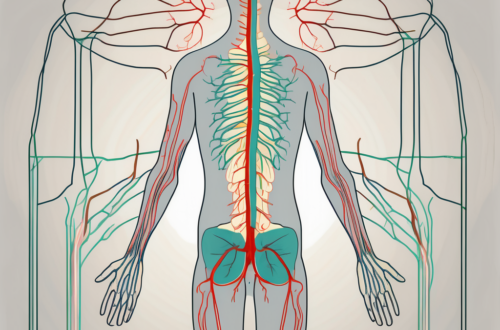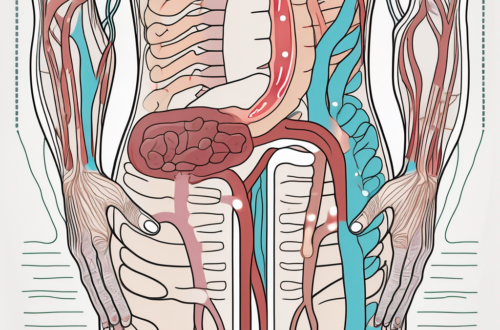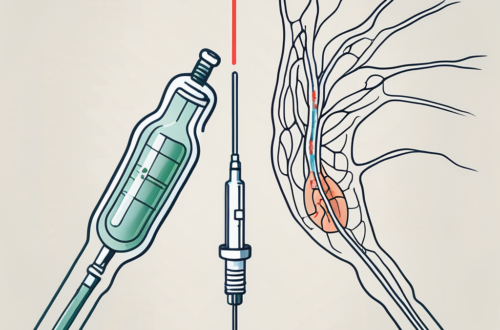The human body is an incredibly complex system, with various processes and functions occurring simultaneously. One of the fundamental aspects of this intricate network is the communication between nerve fibers, which plays a crucial role in maintaining homeostasis and enabling the body to adapt to different situations. An essential component of this communication is the preganglionic neurotransmitter, which acts as a chemical messenger between sympathetic and parasympathetic nerve fibers.
Understanding Neurotransmitters
Before delving into the specific role of preganglionic neurotransmitters, it is important to have a basic understanding of neurotransmitters themselves. Neurotransmitters are chemical substances that allow nerve cells, or neurons, to communicate with one another. They are released by a presynaptic neuron and received by a postsynaptic neuron, transmitting signals across the synapse, or the tiny gap between two nerves.
Neurotransmitters play a crucial role in the intricate web of communication within the nervous system. They are like messengers, relaying information from one neuron to another. Without neurotransmitters, the transmission of signals would be disrupted, leading to a breakdown in communication and impaired functioning of the nervous system.
There are various types of neurotransmitters, each with its own unique functions and effects on the body. Some neurotransmitters, such as dopamine and serotonin, are well-known for their role in mood regulation. Dopamine, for instance, is primarily associated with feelings of pleasure and reward, but it also plays a role in motivation and motor control. Serotonin, on the other hand, is often referred to as the “feel-good” neurotransmitter and is involved in mood regulation, appetite, and sleep.
Other neurotransmitters, like acetylcholine, have a significant impact on specific bodily functions. Acetylcholine, found in both the central and peripheral nervous systems, plays a vital role in muscle movement, cognition, and memory formation. It is essential for the proper functioning of the neuromuscular junction, where nerve impulses are transmitted to muscle fibers, allowing for coordinated movement. Additionally, acetylcholine is involved in cognitive processes such as attention, learning, and memory formation.
The Role of Neurotransmitters in the Nervous System
The nervous system is a complex network of specialized cells that coordinate and regulate bodily functions. It is divided into two main branches: the central nervous system (CNS), which includes the brain and spinal cord, and the peripheral nervous system (PNS), which consists of all the nerves that extend from the CNS to the rest of the body.
Neurotransmitters are key players in the communication between neurons within both the CNS and PNS. They assist in transmitting signals related to various bodily functions, including movement, sensation, memory, and autonomic processes. For example, when you touch a hot stove, sensory neurons in your skin send signals to the spinal cord, which then relays the information to the brain. This transmission of signals is made possible by neurotransmitters, ensuring that you quickly withdraw your hand to avoid injury.
Furthermore, neurotransmitters are involved in the regulation of autonomic processes, which are the involuntary actions that occur in the body, such as heart rate, digestion, and breathing. The release of neurotransmitters in specific areas of the brain and spinal cord helps control these processes, ensuring they function smoothly and efficiently.
Different Types of Neurotransmitters
There are numerous neurotransmitters, each with its own unique functions and effects on the body. In addition to dopamine and serotonin, mentioned earlier, here are a few more examples:
- GABA (gamma-Aminobutyric acid): This inhibitory neurotransmitter helps reduce neuronal excitability and promote relaxation. It plays a crucial role in maintaining the balance between excitation and inhibition in the brain, preventing overstimulation and promoting a state of calmness.
- Glutamate: The most abundant excitatory neurotransmitter in the brain, glutamate is involved in learning, memory, and synaptic plasticity. It plays a crucial role in the formation and strengthening of connections between neurons, allowing for the acquisition of new information and the ability to adapt to changing environments.
- Norepinephrine: This neurotransmitter is involved in the body’s stress response and plays a role in attention, alertness, and mood regulation. It helps prepare the body for action in times of danger or stress, increasing heart rate and blood pressure.
- Endorphins: These neurotransmitters are often referred to as the body’s natural painkillers. They are released in response to pain or stress and help alleviate discomfort while promoting a sense of well-being and euphoria.
These are just a few examples of the diverse array of neurotransmitters that contribute to the complex functioning of the nervous system. Each neurotransmitter has its own unique effects and interactions, working together to ensure the proper functioning of our bodies and minds.
The Sympathetic Nervous System
Now that we have a deeper understanding of neurotransmitters, let us explore the sympathetic nervous system, one of the two main branches of the autonomic nervous system. The sympathetic nervous system is responsible for initiating the body’s “fight-or-flight” response, enabling us to respond quickly to perceived threats or stressors.
When faced with a dangerous situation, the sympathetic nervous system kicks into gear, preparing the body for action. It is like a superhero, ready to save the day. This system is responsible for the surge of adrenaline that courses through our veins, giving us the strength and energy to face any challenge that comes our way.
But what exactly does the sympathetic nervous system do? Let’s delve into its functions and understand how it helps us cope with stress.
Function of the Sympathetic Nervous System
The primary function of the sympathetic nervous system is to mobilize the body’s resources to cope with stress. When activated, it triggers a cascade of physiological responses that prepare the body for action. These responses include increased heart rate, elevated blood pressure, dilation of the airways, and the release of glucose into the bloodstream, among others.
Imagine you are walking in the woods and suddenly come face to face with a bear. Your heart starts racing, your breathing becomes rapid, and your muscles tense up. These are all thanks to the sympathetic nervous system, which is preparing you to either fight the bear or run away as fast as you can.
Additionally, the sympathetic nervous system also plays a role in regulating various bodily functions. It controls the constriction of blood vessels, ensuring that vital organs receive an adequate blood supply during times of stress. It also stimulates the release of sweat, helping to cool down the body during intense physical activity.
While the sympathetic nervous system is crucial in critical situations where an immediate response is necessary for survival, it is important to note that prolonged activation of this system can have detrimental effects on health. Chronic stress, often associated with the continuous activation of the sympathetic nervous system, can lead to various health conditions such as hypertension and cardiovascular diseases.
Now that we have a better understanding of the functions of the sympathetic nervous system, let’s explore the neurotransmitters involved in its communication process.
Preganglionic Neurotransmitters in the Sympathetic Nervous System
Within the sympathetic nervous system, the preganglionic neurons located in the spinal cord release neurotransmitters to communicate with the postganglionic neurons in two ways: via the release of acetylcholine or norepinephrine.
Acetylcholine, often referred to as the “first messenger,” is released by preganglionic neurons and binds to receptors on postganglionic neurons. This binding transmits a signal that ultimately leads to the release of norepinephrine by these postganglionic neurons. This sequential release of neurotransmitters is crucial for maintaining effective communication within the sympathetic nervous system.
Think of these neurotransmitters as messengers delivering important information. Acetylcholine knocks on the door of the postganglionic neurons, signaling them to wake up and get ready. Once awakened, these neurons release norepinephrine, which acts as the second messenger, relaying the information to the target cells.
Understanding the intricate communication process within the sympathetic nervous system gives us a glimpse into the complexity of our body’s responses to stress and danger.
The Parasympathetic Nervous System
Alongside the sympathetic nervous system, the parasympathetic nervous system is responsible for maintaining homeostasis by promoting rest, digestion, and relaxation. Often referred to as the “rest-and-digest” or “feed-and-breed” system, it counters the sympathetic response, bringing the body back to a state of equilibrium.
When we think of the parasympathetic nervous system, we often envision a calm and peaceful state. It is during these moments that our body can focus on replenishing energy and repairing tissues. The parasympathetic system works in harmony with the sympathetic system, ensuring that our bodies can adapt to different situations and maintain overall well-being.
Function of the Parasympathetic Nervous System
The primary function of the parasympathetic nervous system is to conserve and restore energy. When activated, it slows down heart rate, promotes digestion, increases blood flow to the digestive organs, and allows for the elimination of waste.
Imagine yourself sitting down to a delicious meal. As you take your first bite, your parasympathetic system kicks into action. It stimulates the production of saliva, which aids in the breakdown of food and makes it easier to swallow. Simultaneously, it signals the stomach to release digestive enzymes, preparing it to efficiently process the incoming nutrients.
Unlike the sympathetic system, which triggers a broad range of physiological responses, the parasympathetic system is more targeted in its actions, focusing primarily on maintaining homeostasis and promoting efficient digestion and nutrient absorption.
Preganglionic Neurotransmitters in the Parasympathetic Nervous System
Similar to the sympathetic nervous system, the parasympathetic system also relies on preganglionic neurons to release neurotransmitters. However, in the parasympathetic system, the preganglionic neurons release acetylcholine, which then binds to receptors on postganglionic neurons, facilitating communication between neurons. This sequential release of acetylcholine ensures the smooth functioning of the parasympathetic system.
Acetylcholine, often referred to as the “cholinergic neurotransmitter,” plays a vital role in various bodily functions. In addition to its involvement in the parasympathetic system, it is also responsible for transmitting signals between nerve cells in the brain, regulating muscle contractions, and facilitating memory and learning processes.
Understanding the intricate workings of the parasympathetic nervous system allows us to appreciate the complexity of our bodies. It is a remarkable system that ensures our well-being by promoting rest, digestion, and relaxation, ultimately contributing to our overall health and vitality.
The Interaction between Sympathetic and Parasympathetic Systems
While the sympathetic and parasympathetic nervous systems have distinct functions, they do not operate independently. Instead, they both work together to maintain equilibrium in the body, allowing it to function optimally under a wide range of circumstances.
The sympathetic nervous system is responsible for the body’s “fight or flight” response, which prepares us for action in times of stress or danger. It increases heart rate, dilates blood vessels, and releases stress hormones like adrenaline. On the other hand, the parasympathetic nervous system is responsible for the body’s “rest and digest” response, which promotes relaxation, digestion, and energy conservation.
Balancing Act: Sympathetic and Parasympathetic Systems
Maintaining a balance between sympathetic and parasympathetic activity is crucial for overall health and well-being. When one system dominates over the other, it can disrupt normal physiological functioning and lead to various health issues.
For example, chronic stress and prolonged sympathetic activation can lead to a range of conditions, including hypertension, cardiovascular diseases, and digestive disorders. The constant release of stress hormones can put a strain on the cardiovascular system and impair digestion. On the other hand, an overactive parasympathetic system may result in excessive relaxation, sluggish digestion, and decreased heart rate.
Striking a balance between the sympathetic and parasympathetic systems can be achieved through various techniques such as stress management, regular exercise, and mindfulness practices. These activities help to activate the parasympathetic system, promoting relaxation and counteracting the effects of chronic stress.
Impact of Preganglionic Neurotransmitters on System Interaction
The role of preganglionic neurotransmitters, particularly acetylcholine and norepinephrine, in the interaction between the sympathetic and parasympathetic nervous systems cannot be overstated. Their precise regulation ensures effective communication between neurons within each system and contributes to the overall balance between the two systems.
Acetylcholine is the primary neurotransmitter released by the parasympathetic system, while norepinephrine is primarily released by the sympathetic system. These neurotransmitters bind to specific receptors on target cells, triggering a cascade of physiological responses.
However, further research is needed to fully understand the intricate mechanisms involved in this interaction. Unanswered questions remain regarding the specific impact of preganglionic neurotransmitters on the balance between the sympathetic and parasympathetic systems and how these interactions may influence overall health and disease.
Recent studies have suggested that imbalances in the release or response to these neurotransmitters may contribute to various disorders. For example, dysregulation of acetylcholine signaling has been implicated in conditions such as Alzheimer’s disease, while abnormalities in norepinephrine signaling have been linked to mood disorders like depression.
Understanding the complex interplay between the sympathetic and parasympathetic systems and their neurotransmitters is essential for developing targeted therapies and interventions to restore balance in individuals with imbalances or dysfunctions in these systems.
Future Research Directions in Neurotransmitter Study
As our understanding of the intricate workings of neurotransmitters continues to grow, it opens the door to exciting possibilities for the field of neuroscience. Ongoing research aims to address the many unanswered questions surrounding the role of preganglionic neurotransmitters in both the sympathetic and parasympathetic nervous systems.
Neurotransmitters are chemical messengers that play a crucial role in communication between nerve cells. They are involved in a wide range of physiological and psychological processes, including mood regulation, motor control, and sensory perception. Preganglionic neurotransmitters, in particular, are of great interest to researchers due to their involvement in the autonomic nervous system.
The autonomic nervous system is responsible for regulating involuntary bodily functions, such as heart rate, digestion, and breathing. It consists of two branches: the sympathetic nervous system, which prepares the body for “fight or flight” responses, and the parasympathetic nervous system, which promotes “rest and digest” activities.
Unanswered Questions about Preganglionic Neurotransmitters
Researchers are currently investigating various aspects of preganglionic neurotransmitters, including the specific receptors involved in their actions, the impact of genetic factors on neurotransmitter regulation, and the potential therapeutic applications of manipulating preganglionic neurotransmitter pathways.
One area of interest is the identification and characterization of the receptors that preganglionic neurotransmitters bind to. Understanding the specific receptors involved can provide insights into the mechanisms underlying their actions and potentially lead to the development of more targeted therapies.
Genetic factors also play a role in neurotransmitter regulation. Researchers are exploring how variations in genes that code for neurotransmitter receptors or enzymes involved in neurotransmitter synthesis and degradation may influence neurotransmitter function. This knowledge could help identify individuals who may be more susceptible to certain medical or psychological conditions and guide personalized treatment approaches.
Furthermore, researchers are investigating the potential therapeutic applications of manipulating preganglionic neurotransmitter pathways. By modulating the release, reuptake, or breakdown of these neurotransmitters, it may be possible to restore balance in the autonomic nervous system and alleviate symptoms associated with various medical and psychological conditions.
By answering these questions, we may gain valuable insights into the complex interplay between the sympathetic and parasympathetic systems and uncover potential strategies for targeting preganglionic neurotransmitters in the treatment of various medical and psychological conditions.
Potential Implications for Medical and Psychological Treatments
Understanding the role of preganglionic neurotransmitters in the autonomic nervous system could have significant implications for medical and psychological treatments. By manipulating the release or activity of these neurotransmitters, clinicians may be able to modulate autonomic functions and potentially alleviate symptoms associated with various medical conditions, including cardiovascular disorders, mental health conditions, and gastrointestinal disorders.
For example, in individuals with cardiovascular disorders, such as hypertension or arrhythmias, targeting preganglionic neurotransmitters involved in heart rate regulation could help restore normal cardiac function. Similarly, in mental health conditions like anxiety or depression, modulating neurotransmitter activity in the autonomic nervous system may contribute to improved emotional well-being.
It is crucial to note, however, that any medical interventions should be conducted under the guidance of healthcare professionals. The autonomic nervous system is a complex network, and altering neurotransmitter function requires careful consideration of potential risks and benefits. If you have concerns or questions about your autonomic nervous system function or related health conditions, it is always advisable to consult with a qualified healthcare provider who can provide appropriate advice and guidance based on your individual needs.
Concluding Thoughts
The study of preganglionic neurotransmitters and their role in the communication between sympathetic and parasympathetic nerve fibers is an ongoing and fascinating area of research. By deepening our understanding of these neurotransmitters and their complex interactions, we can gain valuable insights into the functioning of the autonomic nervous system and its relevance to overall health and well-being.
While much progress has been made, there is still much to learn about the intricate mechanisms and potential implications of preganglionic neurotransmitters. Continued research in this field could pave the way for innovative therapies and treatments that target the autonomic nervous system, providing hope for improved medical and psychological outcomes in the future.





